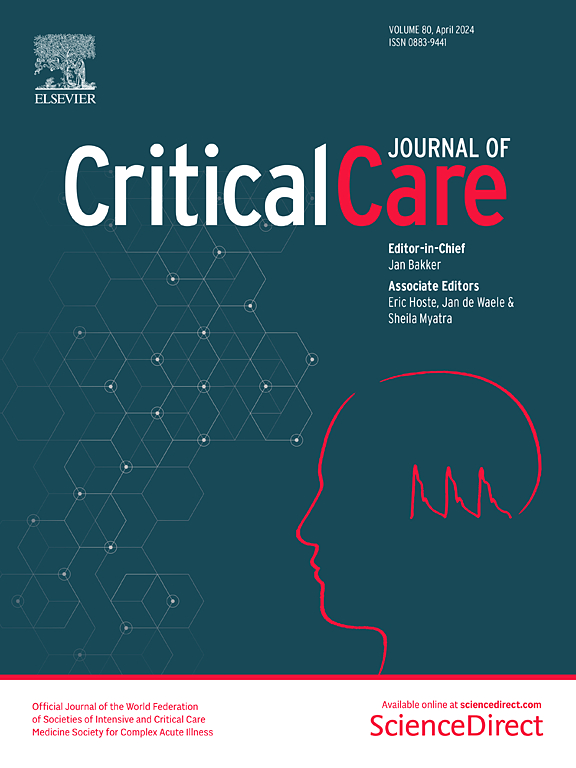Net albumin leakage in patients in the ICU with suspected sepsis. A prospective analysis using mass balance calculations
IF 8.8
1区 医学
Q1 CRITICAL CARE MEDICINE
引用次数: 0
Abstract
Albumin kinetics in septic shock have been extensively studied, but clinical recommendations remain weak. An increased transcapillary escape rate (TER) of albumin has been demonstrated, though TER does not account for lymphatic return. Mass balance calculations, considering lymphatic return, have been used to assess net albumin leakage (NAL) in major surgery but not in sepsis. This study aimed to evaluate NAL in ten ICU patients with suspected sepsis, hypothesizing a net positive leakage. Secondary aims included investigating associations between NAL and fluid overload, glycocalyx shedding products, and cytokines, as well as identifying factors associated with it. This prospective, observational study included ten patients within twelve hours of ICU admission for suspected sepsis at Karolinska University Hospital Huddinge. Albumin, hematocrit, and hemoglobin levels were sampled at 0, 1, 2, 4, 8, and 24 h. NAL was estimated using mass balance calculations, comparing proportional changes in albumin and hemoglobin concentrations over time, adjusted for albumin and hemoglobin infusions and losses. A proportionally greater decrease or smaller increase in albumin compared to hemoglobin indicated NAL, representing the net leakage from the circulation to the interstitium minus lymphatic return. Over 24 h, patients exhibited a net positive albumin leakage to the interstitium of 8 ± 10 g (p = 0.029). NAL showed no correlation with glycocalyx shedding products or fluid overload but had a weak correlation with interleukin-6 and interleukin-8 in the first 4 h. Albumin infusions appeared to increase net leakage. This study demonstrated a net positive albumin leakage of 8 ± 10 g over 24 h in ICU patients with suspected sepsis, with a weak early correlation to pro-inflammatory cytokines but no significant link to fluid balance or glycocalyx shedding. Notably, albumin infusions were associated with increased net leakage.ICU疑似脓毒症患者的净白蛋白渗漏。使用质量平衡计算的前瞻性分析
感染性休克中的白蛋白动力学已被广泛研究,但临床建议仍然薄弱。白蛋白经毛细血管逃逸率(TER)的增加已被证实,尽管TER不能解释淋巴回流。考虑淋巴回流的质量平衡计算已被用于评估大手术的净白蛋白渗漏(NAL),但不适用于败血症。本研究旨在评估10例疑似脓毒症的ICU患者NAL,假设净阳性渗漏。次要目的包括研究NAL与液体超载、糖萼脱落产物和细胞因子之间的关系,以及确定与NAL相关的因素。这项前瞻性观察性研究纳入了10例在卡罗林斯卡大学哈丁医院因疑似脓毒症入院12小时内的患者。在0、1、2、4、8和24小时取样白蛋白、红细胞压积和血红蛋白水平。利用质量平衡计算来估计NAL,比较白蛋白和血红蛋白浓度随时间的比例变化,并根据白蛋白和血红蛋白输注和损失进行调整。与血红蛋白相比,白蛋白比例较大的减少或较小的增加表明NAL,代表从循环到间质的净泄漏减去淋巴回流。在24小时内,患者表现出净阳性白蛋白渗漏到间质8±10 g (p = 0.029)。NAL与糖萼脱落产物或液体超载无关,但在前4小时与白细胞介素-6和白细胞介素-8有较弱的相关性。白蛋白输注似乎增加了净渗漏。该研究表明,疑似脓毒症的ICU患者24小时内净阳性白蛋白渗漏为8±10 g,与促炎细胞因子的早期相关性较弱,但与液体平衡或糖萼脱落无显著联系。值得注意的是,白蛋白输注与净渗漏增加有关。
本文章由计算机程序翻译,如有差异,请以英文原文为准。
求助全文
约1分钟内获得全文
求助全文
来源期刊

Critical Care
医学-危重病医学
CiteScore
20.60
自引率
3.30%
发文量
348
审稿时长
1.5 months
期刊介绍:
Critical Care is an esteemed international medical journal that undergoes a rigorous peer-review process to maintain its high quality standards. Its primary objective is to enhance the healthcare services offered to critically ill patients. To achieve this, the journal focuses on gathering, exchanging, disseminating, and endorsing evidence-based information that is highly relevant to intensivists. By doing so, Critical Care seeks to provide a thorough and inclusive examination of the intensive care field.
 求助内容:
求助内容: 应助结果提醒方式:
应助结果提醒方式:


